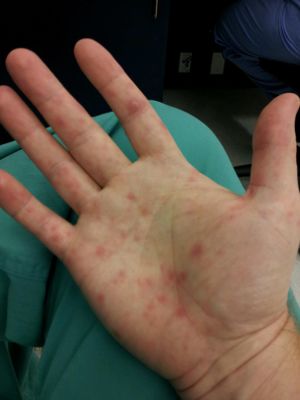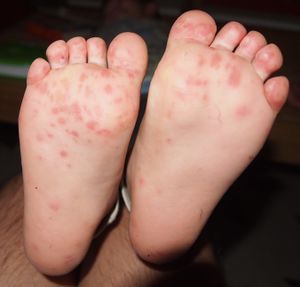We need you! Join our contributor community and become a WikEM editor through our open and transparent promotion process.
Hand-foot-and-mouth disease
From WikEM
Contents
Background
- Caused by coxsackie virus
- Most frequently in children, but can occur in all age groups
- Similar to Herpangina, but with additional hand/foot lesions
Clinical Features
- Brief prodrome with low fever, anorexia, sore mouth
- Oral lesions appear 1-2d later
- Vesicles on erythematous base, will then ulcerate
- Painful
- Found on buccal mucosa, tongue, soft palate and gingiva
- Hand/foot lesions
- Red papules that change to gray vesicles
- Resolves after 7–10 days
Complications
- Some children get a desquamation of the nails around 2 weeks afterwards (self resolves)
- Meningitis and encephalitis are uncommon, yet still possible complications[1]
Differential Diagnosis
Pediatric Rash
- Drug rash
- Erythema Infectiosum (Fifth disease)
- Hand-foot-and-mouth disease
- Henoch-Schonlein Purpura (HSP)
- Herpangina
- Herpes simplex virus
- Infectious Mononucleosis
- Meningitis
- Measles
- Molluscum contagiosum
- Roseola infantum
- Rubella German measles)
- Scarlet fever
- Smallpox
- Varicella (Chickenpox)
Vesiculobullous rashes
Febrile
- Diffuse distribution
- Varicella
- Smallpox
- Disseminated gonococcal disease
- DIC
- Purpural fulminans
- Localized distribution
- Necrotizing fasciitis
- Hand-foot-and-mouth disease
Afebrile
- Diffuse distribution
- Bullous pemphigoid
- Drug-Induced bullous disorders
- Pemphigus vulgaris
- Phytophotodermatitis
- Erythema multiforme major
- Localized distribution
Evaluation
- Clinical diagnosis, based on history and physical examination
- If unsure, see Pediatric Fever
Management
- No specific therapy for most; self-limited
- NSAIDS and cool liquids for pain
- Encourage good hand hygiene to prevent spread
- Some recommend Magic Mouthwash/oral lidocaine if not tolerating PO intake, although evidence suggests no better than placebo[2]
- In infants, do NOT use oral lidocaine due to risk of lidocaine toxicity and FDA black box warning[3][4]
Disposition
- Discharge
See Also
References
- ↑ Bonfante G and Rosenau AM. Rashes in Infants and Children: in Tintinalli JE, Stapczynski S, et al (eds): Tintinalli’s Emergency Medicine: A Comprehensive Study Guide, ed 7. McGraw-Hill, 2011. Ch (134).
- ↑ Hopper S. et al. Topical lidocaine to improve oral intake in children with painful infectious mouth ulcers: a blinded, randomized, placebo-controlled trial. Ann Emerg Med. 2014 Mar;63(3):292-9
- ↑ FDA recommends not using lidocaine to treat teething pain. http://www.fda.gov/Drugs/DrugSafety/ucm402240.htm
- ↑ Curtis LA, Dolan TS, Seibert HE. Are one or two dangerous? Lidocaine and topical anesthetic exposures in children. J Emerg Med 2009;37:32-39
Video


